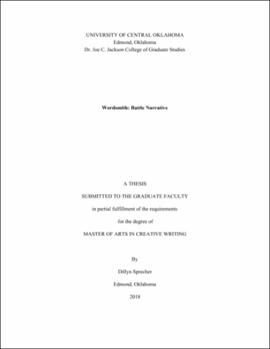| dc.description.abstract | Graphic novels are an emergent form of literature that combine text and illustrations to present narrative works in a visually engaging display. The following thesis is a graphic novel in the genre of science fiction. It is infused with other fiction genres such as tall tales, fantasy, and mystery as its characters write their own narratives. This thesis draws inspiration from various works, widely spanning from Geoffrey Chaucer's Canterbury Tales to the Japanese manga, Yu-Gi-Oh!. First, the rich characterization presented in the Canterbury Tales inspired the depth of character development in this creative project. In Wordsmith: Battle Narrative, every character is intended to have an appealing and relatable backstory. Another source of inspiration came from A Contract with God and Other Tenement Stories by Will Eisner. Eisner's work established and popularized the genre of the graphic novel. Furthermore, the genre has continued to be legitimized through important and deep works such as Art Spiegelman's Maus and Frank Miller's The Dark Knight Returns. In terms of modern works, The Phantom Tollbooth by Norton Juster was also heavily influential to this thesis. Like in The Phantom Tollbooth, in this graphic novel, the characters take skills learned in the classroom and apply them to clearly defined situations within the story. It was necessary that these situations would feel organic despite their fictional undertones. Finally, the Japanese manga, Yu-Gi-Oh!, inspired the concept of using technology and holograms to portray one's ideas. In Yu-Gi-Oh! the holograms display card games; in Wordsmith: Battle Narrative, holograms are used in a writing contest. The main objective of this work is to get struggling students excited about reading and writing. This work introduces and reviews English learning standards by engaging students in an entertaining narrative. This graphic novel was developed as a work to be used in the classroom by a sixth-grade English teacher of struggling readers, many of which are English language learners. A graphic novel is a fitting medium as these students benefit from the use of visual aids, chunked reading, and in-depth study and review of vocabulary words and writing concepts. Challenges arose in the creation process while trying to meet students' needs and incorporate learning standards. Pages would find themselves bloated with too much action or dialogue. Ideas were generated to address learning standards, but were removed from the script because they felt too artificial from a reader's perspective. In addition, the concept of a sustained narrative work of this magnitude also presented its own problems. In early drafts, the thesis seemed to have two competing plots with an undefined central antagonist. To address crowded script pages, pages were drawn out in panels to visually imagine how the finished page would look. This process revealed errors and helped in the overall editing. Instead of just thinking of the graphic novel as a script, consideration began to develop for the work as a completed work. To maintain a consistent plot and rhythm, outlines were created and the necessity of scenes was considered. The result cut several pages of unneeded exposition and addressed the plot. One of the competing plots was restructured and used as a catalyst for another. The significance of this project is to show the importance and utility of the graphic novel in developing literacy in struggling readers. Graphic novels and comic books are underutilized in schools. This project could influence similar works to be used in classrooms to address the needs of students of all ages and backgrounds. While various types of literature are used in the classroom, this graphic novel represents an intentional approach with English learning standards interwoven throughout the work. | |
